Date 7 November 2000 | ||
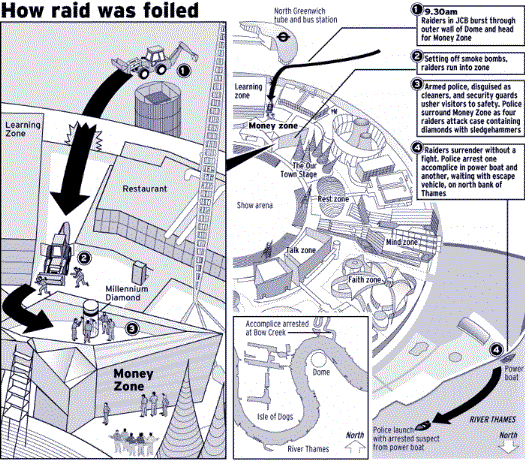 | ||
Perpetrators Lee WenhamRaymond BetsonWilliam CockramTerry MillmanAldo CiarrocchiRobert AdamsKevin Meredith | ||
The Millennium Dome raid was an attempted robbery of the Millennium Dome's diamond exhibition in Greenwich, South East London occurring on 7 November 2000. A local gang planned to ram-raid the De Beers diamond exhibition which was being held in the dome at the time. The gang had then planned to escape via the Thames in a speedboat. The De Beers diamond exhibition had a number of jewels on display including the Millennium Star, a flawless 203.04 carats (40.608 g) gem with an estimated worth of £200 million and considered one of the most perfect gems in the world. Also on display were priceless blue diamonds. The attempted robbery was foiled by the Flying Squad of the Metropolitan Police Service, as a result of information from Kent Police Serious Crime who already had the gang members under surveillance for their suspected roles in a number of unsuccessful armoured vehicle robberies. The operation to foil the robbery was the biggest operation undertaken in the Flying Squad's history and at trial the judge in the case commended the way it was carried out.
Contents
- Operation Magician
- Surveillance
- Aborted robbery attempts
- Day of raid
- Trial
- Aftermath
- In popular culture
- References
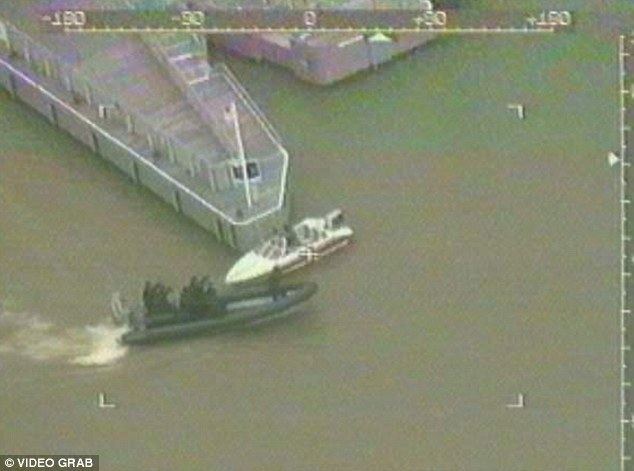
If the heist had succeeded, then with a haul of £350 million worth of diamonds, it would have become the biggest robbery in history at the time.
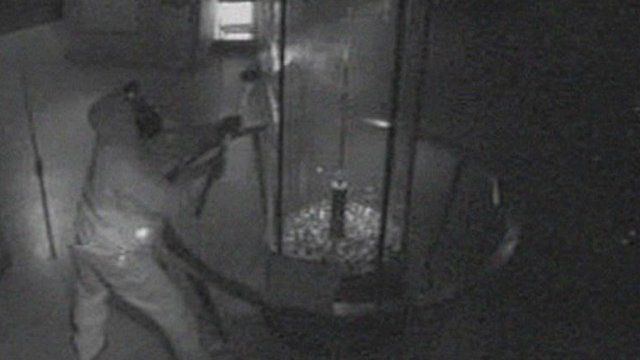
Operation Magician
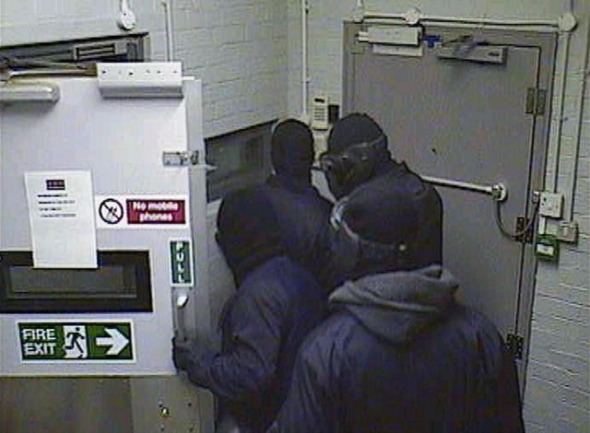
In the summer of 2000, the Flying Squad became aware of a major armed robbery plot after a tip-off was received. The location of this robbery was unclear, but the identities of some of the robbers were known to the police. The police spent a number of months developing intelligence on the plot and set up an operation that they codenamed Operation Magician. During the intelligence gathering the location of the robbery was found to be the Millennium Dome in Greenwich.

In February 2000, armed men tried to pull off a £10 million raid on a security van in Nine Elms, South London. The gunmen had stopped the security lorry by blocking off both ends of Nine Elms Lane. They had planned to use their own lorry, which was carrying Christmas trees, as a battering ram. This lorry had a huge metal spike welded into the chassis and covered by the foliage. The gang planned to split the security lorry's rear doors with the ram. The gang's plan failed when a motorist who was late for work removed the keys from the ignition of the unattended Christmas tree van. The robbers, left with no choice, made their escape in an inflatable speedboat towards Chelsea.

It was attempted again on 7 July in Aylesford, Kent. This time, the gang got even closer to the cash, with the metal spike being rammed into the van. They were seconds from taking the money when an unexpected police car appeared; the gang shot at the approaching car and again made their escape in an inflatable speedboat.
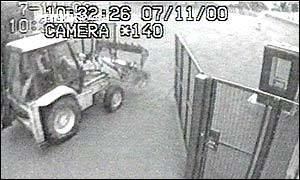
Detective Superintendent Jon Shatford stated that this attempted robbery brought to his attention a gang which was capable of carrying out a robbery with this level of planning. Fifteen months after this attempted robbery, there was another case where a gang tried to pull off another robbery using similar techniques. This unsuccessful attack provided the police with important clues and led them to track some of the vehicles that were used in the raid to two isolated farms in rural Kent; these properties were then put under 24-hour surveillance.
After this unsuccessful robbery the police received a tip-off about the Dome raid from an informer. At a meeting between detectives to discuss the Nine Elms Lane attempted robbery and the information that the informer had provided about the Dome raid, one detective who had recently visited the dome quipped, "Maybe they are after the Millennium jewels?" It was this comment that led to beginning an investigation into the raid.
Surveillance
On 1 September 2000 the team identified three of the suspected robbers – Lee Wenham, Raymond Betson and William Cockram – at the Dome. It was then found that every time they had visited the attraction, the Thames was at high tide. They were observed visiting the exhibition and recording video footage, leading the police to suspect that the exhibition could be a target. The surveillance on the men was significantly increased and the Dome was placed under close watch. The precautions taken by the Flying Squad included replacing the priceless gems with replicas of the same size, allowing the originals to be stored elsewhere. Due to an increase in surveillance, the police discovered other members of the gang. These included Terry Millman, who was tasked with obtaining the getaway speedboat which was to be used for the escape. Cockram and Betson were also observed filming the surrounding river and jetty. The surveillance on the gang continued and their visits to the Dome became more frequent. In late September a few members of the gang were spotted testing a speedboat in a harbour in Kent.
Aborted robbery attempts
The Metropolitan Police were able to identify the possible days upon which the raid could take place and communicated this information to De Beers and the Dome's management. Two of the days that the police had identified resulted in aborted attempts. The first aborted attempt occurred in early October and was called off due to the malfunctioning of the speedboat which was to be used for the getaway. The second aborted attempt occurred one day before the date of the actual raid, but was cancelled upon the gang discovering the tide was too low to ensure a safe getaway.
After this attempt the police suspected the raid was imminent and were convinced the raid would take place the following day. The police then replaced all Dome staff with armed undercover officers. On a number of days in October, the gang under surveillance looked as if they were about to commence the raid.
Some members were spotted towing a speedboat to Greenwich and then placing the boat in the river opposite the Dome. This activity indicated to the Squad that the robbery was close; however, this was not the case. The delay was then investigated by police. The detectives analysed the times and days of the aborted attempts and found that they had something in common – the high tide. Upon closer investigation the detectives found that, on each of the days when the robbery was aborted, the tide was at its highest possible level. The police began to investigate the patterns of the tide and were able to predict the possible times that the raid was to take place. One of the predicted days happened to be the date of the actual raid.
Day of raid
On 7 November at 9:30am, Operation Magician was underway and was commanded by Detective Superintendent Jon Shatford of the Metropolitan Police. The officers involved in the operation included a total of two hundred officers, of which forty were from the Specialist Firearms Command (SCO19). A further sixty armed Flying Squad officers were stationed around the Thames, and twenty on the river itself to hamper any escape attempts. Surveillance officers were also disguised as Dome employees. The Millennium Dome's CCTV room was used by the police as a control room.
All the officers were briefed at 3am on the day of the raid on the contingency plans that were in place. Before the raid some officers were positioned behind a dummy wall and others were dressed as cleaners and Dome employees with their firearms concealed. Before the raid four members of the gang were identified in a JCB earth digger and all were wearing body armor with gas masks. The men were armed with smoke bombs, sledgehammers and nail guns and these were to be used to penetrate the security glass protecting the exhibit. The digger was used by the gang to break through the perimeter fence and to crash through the side wall of the Dome to reach the Money Zone, the section where the De Beers diamonds were kept. The digger came into the Dome itself and it parked outside the Money Zone.
Once inside Ciarrocchi started throwing smoke bombs and Cockram attempted to break the glass where the diamonds were stored. Inside the Dome, Cockram knew that the glass could resist the force of a 60-ton ram raid but his plan was to weaken the glass with three shots from a powerful Hilti nailgun and then another gang member, Robert Adams, would then use a sledgehammer to break the weakened glass. The plan was working and the gang were inches away from the diamonds. Adams was quoted as saying "I was twelve inches from pay day," later stating, "It would have been a blinding Christmas."
The police pounced on four members of the gang as they attempted to smash their way into the display case using sledgehammers and a nail gun. As these four men were being arrested, the other officers who were stationed around the Dome arrested another man who was in a high-powered boat on the Thames. The police also arrested another man whom they suspected of monitoring police radio frequencies. This suspect was detained on the north shore of the Thames opposite the Dome. All the suspects were apprehended; Millman was apprehended in a van. Once all the suspects had been detained they were taken to police stations in South London. On the day of the raid, by 1200 GMT some areas of the Dome had re-opened, but other areas, including the Money Zone, were cordoned off.
At the scene of the arrest David James, the Dome's former executive chairman, stated "They were all on the ground trussed up like Christmas turkeys." He added, "It was relatively calm and they were almost joking with the police who were standing over them with guns". DS Shatford defended the decision that was taken to wait until the gang had reached the diamonds before arresting them. He said "Our chief concern throughout was public safety. We decided it was better to let the robbers get to the vault where they were effectively imprisoned.
The serious crime unit of the Kent Police worked in conjunction with the Metropolitan Police Service and arrested six more people in connection with the raid on the Dome on Tuesday morning in the villages of Collier Street and Horsmonden. Police said the ages of the men ranged between 38 and 62.
Trial
The case came to trial a year later on 8 November 2001. It was heard at the Old Bailey and only six members of the gang were present as Terry Millman had died of cancer. The court heard that Betson, Cockram, Ciarrocchi and Adams were caught by officers who were undercover in the dome when they burst into the dome using a JCB digger. On the first day of the defence case, Cockram discussed the lack of security inside the dome. "I couldn't believe how simple it was", he also added "I was thinking, this cannot be true, It was a gift. At first I had thought it was pie in the sky, but after going down there I couldn't believe security was so bad... There was nobody in the vault, no security workers walking around.". He stated that had the plan succeeded "It would have taken a very short time from hitting the main gate to getting back across the Thames – five minutes maximum.". In his defense Cockram also added "No one was going to get hurt – there was no one to hurt,", "The dome was always empty.". Cockram explained that the nail gun that was bought by the gang was to be used to break the glass in the vault and not as a weapon. The ammonia he said was to be used to contaminate any traces of blood left by him. He explained that the body armor that he wore was to be used after the raid for protection when he was scheduled to attend a meeting with associates to discuss the sale of the gems. Betson at trial told the jury that his brother in law Pc Michael Waring who was working at the Dome as part of the perimeter security had told him about a school friend named Tony who was also working at the dome. Betson claimed that Waring had told him about a plan that Tony had put together," Tony had got this plan together. He had a backer – someone to buy the jewellery. He said the security was crap".
Betson then went on to say, "I had every confidence in him – there was no way I thought he would betray me – not for two seconds". "If this had come to me from someone else – in a pub – I would not have gone along with it but it was the background to where it had come from. It was solid". Betson explained how he developed a trusting relationship with Waring, he said "I did not think he would try and do me any harm. I trusted him." At the trial the jury were also told by Cockram that Betson had told him, that his brother in law was in on the plan. Cockram went on to say "He said he had inside help through Pc Michael Waring". When called as a prosecution witness Pc Waring "totally denied" he was part of the plan or had offered to act in a criminal way by providing information on security.
At the trial the jury were told that the gang had invested tens of thousands planning the raid and they stored the equipment they needed at a disused commercial yard in Plumstead, South-East London, as well as two remote Kent farms near Maidstone. Terry Millman who had died of cancer before the trial date used the name T. Diamond when he paid £3,700 in cash to purchase a getaway speed-boat at a yard in the seaside town of Whitstable, Kent.
At the trial, Crown prosecutor Martin Heslop, QC, said "the raid was planned professionally, carefully and down to the last detail" he also added "So well organised was it that it would probably have succeeded, had it not been for an equally professional, careful and detailed police operation". Heslop stated that in order to minimize the risk to the public "Arrangements were made to keep children away from the danger area, but for obvious reasons it was not practicable to alert all staff to the possibility of an attack".
The time taken for the case to be heard was three months, the jury which consisted of seven women and five men reached a 10–2 majority verdict against the defendants after deliberating for nearly seven court days. After a week of deliberations the judge Michael Coombe accepted the majority verdict and this resulted in the men being found guilty.
The judge told the defendants "You played for very high stakes and you must have known perfectly well what the penalty would be if your enterprise did not succeed". The judge added "This was a wicked, professional plan and one which was carried out with the minutest attention to detail. Mercifully the police were on to it."
Raymond Betson and William Cockram who were considered the two leaders of the gang were each given 18-year sentences. Betson at trial blamed his brother in law Michael Waring who was a serving police constable at the time. Betson claimed Waring supplied him with inside information and was also involved. Waring denied the allegation and was exonerated by the judge.
Aldo Ciarrocchi and Robert Adams were sentenced to 15 years. Kevin Meredith was cleared of conspiracy to rob but found guilty of conspiring to steal and was sentenced to five years.
After sentencing, Shatford, who was now in charge of the Serious Crime Group in North-East London stated "I'm delighted with the verdict and sentence. They were a ruthless team of criminals. Had it not been for the police they would have committed the largest robbery ever to take place anywhere in the world". He added: "I believe Betson was the mastermind. He is a dangerous man and was known to the Flying Squad. I believe he was responsible for a large number of armed robberies in the past." He speculated that if the raid had been successful, the Russian mafia would have been involved in the disposal of the diamonds.
Aftermath
William Cockram, who was sentenced to 18 years for his part in the raid, was awarded legal aid to sue the Metropolitan Police Service in March 2003. The decision to award Cockram the money was condemned by the then-shadow home secretary David Davis. Cockram claimed that he was assaulted by a police officer at about 9.39am on the day of the raid as he was lying handcuffed on the floor.
One of the diamonds on display during the raid was a pear-shaped rare blue diamond. In March 2010 the London Evening Standard reported that the gem would be sold in a collection at Sotheby's Hong Kong the following month. The blue diamond, which had an estimated worth of £3 to £3.8 million, was sold for £4.2 million in April 2010 in Sotheby's Hong Kong.
The Flying Squad arrested a man they believed was the mastermind behind the plot; this man, however was not present on the day of the raid. The man, Londoner James Hurley, was arrested following an undercover operation led by The Mail on Sunday. The undercover operation tracked Hurley to Puerto Banus in the Costa del Sol. The officer in charge of Operation Magician, Detective Chief Superintendent Jon Shatford, arrived in Spain with a team of three others and an emergency warrant for Hurley's arrest. Hurley had been under surveillance by the police when he was spotted refining and testing the robbery plan for weeks in advance. He was dubbed the "boatman" by the police as he was seen taking photographs of the Dome from vessels on the Thames and organising the speedboat which was to be used for the getaway. Hurley disappeared at the last minute before the raid took place. After his disappearance the National Criminal Intelligence Service and the Spanish police were unable to locate him. Hurley was found by the Mail on Sunday operation, living in a luxury villa on a private enclave close to Puerto Banus. Once Hurley had been photographed and his identity confirmed, a High Court judge in London issued a red extradition warrant for his arrest.
The JCB digger that was used in the raid was put up for auction, although it still displayed damage from the raid. The digger was sold at JCB's biannual auction of surplus parts and machines. The JCB company took possession of the machine from insurers after a court hearing.
